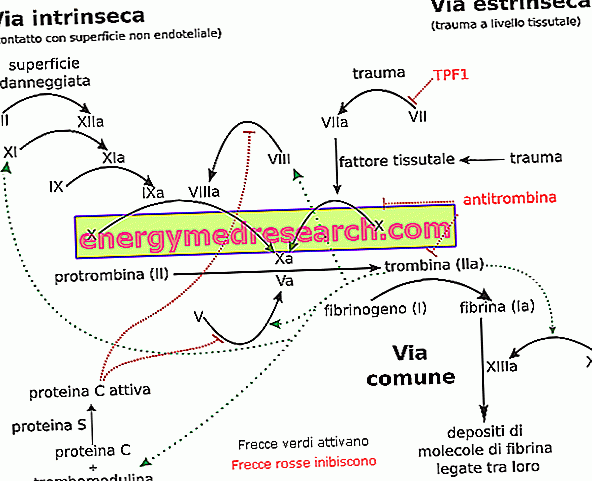What is Psoriasis?
Psoriasis is an inflammatory, chronic and non-contagious disease of the skin, which in Italy affects about two million people (3.1% of the inhabitants). Worldwide, it has been estimated that psoriasis affects a percentage between 0.6 and 5% of the population.
The disease can occur at any age, but usually appears for the first time between the ages of 20 and 30, while it is rare in children; a second incidence peak is recorded in the age group between 50 and 60 years. In general, an early appearance of psoriasis (before the age of 15) is associated with a more severe form.
Psoriasis has the same incidence in both sexes; in a good percentage of cases it tends to regress in the summer and then flare up again in the winter months.
Generally, psoriasis comes in the form of patches and red plates, covered with whitish scales, located mainly in the knees, in the sacral region, in the elbows, in the hands, in the feet and in the scalp.
Psoriasis: Most frequent signs and symptoms
- flaking;
- itch
- Erythema (redness)
- Sense of tension
- "Bleeding"
- heartburn
Types of psoriasis
Considering the numerous forms under which it can be presented, it is not correct to speak of psoriasis as a single pathology. The size of the individual patches, for example, is extremely variable (from a few mm up to several cm), as well as the shape, location, evolution and color tone.
Doctors distinguish five major clinical variants of psoriasis:
- plaque psoriasis : over 80% of cases
- guttate psoriasis : about 10% of cases
- Inverse psoriasis : may occur in conjunction with plaque psoriasis, or in an isolated manner
- erythrodermic psoriasis : less than 3% of cases
- pustular psoriasis : less than 3% of cases
Not all of these variants are always well defined, and more clinical forms of the disease may be present in the same patient.
Vulgar psoriasis
The most common form is psoriasis vulgaris, also known as plaque psoriasis or patchy psoriasis .
It generally occurs in adulthood, typically involving the scalp, elbows, knees and lower back.
It is characterized by the appearance of raised red patches, well defined and surmounted by abundant white-silvery, thick and dry scales. Tendentially itchy, these lesions tend to spontaneous desquamation and are easily removed with scratching (to avoid!), Leaving punctate hemorrhages due to the rupture of the underlying capillaries.
The patches are large and tend to merge, thus affecting large areas of the trunk and limbs.
The disease has a recurrent chronic course, ie it is subject to attenuation, regression and reappearance of symptoms.

Psoriasis Guttata
Guttate psoriasis is characterized by small patches that resemble drops (its name derives from the Latin gutta, which means precisely drops).
Guttate psoriasis is the most common form in childhood and adolescence; often it is often preceded by a streptococcal pharyngitis.
Injuries can appear suddenly and disappear over a few weeks.

Credits: www.webmd.com
Reverse Psoriasis
The psoriasis of the folds (also called inverted psoriasis or fissure psoriasis ), develops electively in the skin folds, such as the groin, the intergluteal fold, the submammary folds and the genital area in general.
This form of psoriasis is particularly frequent in obese and / or diabetic subjects, and in the elderly.

Pediatric folds of psoriasis - Credits: Mayo Foundation
Erythrodermic Psoriasis
In erythrodermic psoriasis, a large part of the body is red and inflamed. Almost all the skin (over 80%) is affected by generalized erythema.
Erythema and exfoliation of the skin cause itching, pain and swelling.
Erythrodermal Psoriasis can appear after abruptly interrupted cortisone or immunosuppressive therapies, and precipitate due to infections or drugs.
This form of psoriasis is particularly disabling for the patient and in many cases requires hospitalization; it can in fact lead to severe dehydration and infections.

Credits: www.webmd.com
Poriatic Psoriasis
Pustular generalized psoriasis is another very serious form of psoriasis, which presents with yellowish-brown pustules with purulent contents (filled with pus).
It is also associated with fever, malaise, paresthesia and burning sensations. It can cause fever and other complications, such as dehydration and bacterial sepsis. As with the erythematous form, it can be triggered by the interruption of a systemic treatment with corticosteroids.
There is also a variant of localized pustular psoriasis, quite frequent, which is localized to the palms of the hands and the soles of the feet.

Credits: www.psoriasisexpert.org
Scalp Psoriasis
Scalp psoriasis - often confused with dandruff or seborrheic dermatitis - is characterized by the presence of patches that remain localized on the scalp, without extending to the other parts of the body. The plates thicken and peel off over time.
Sometimes it can also affect the forehead, the back of the neck and the ears.
Psoriasis of the scalp is in no way related to hair loss but, especially in the most nervous subjects, it causes intense and annoying itching.

Other Forms of Psoriasis
There are also numerous other forms that affect different areas of the body such as
- plantar palm psoriasis involving the palms of the hands and the soles of the feet;
- nail psoriasis, which affects the nails and is found in over a third of patients;
- ocular psoriasis ;

Nail psoriasis - Credits: www.webmd.com
Psoriatic Arthritis
To learn more: Psoriatic Arthritis
Arthropathic psoriasis, which affects about 20-30% of patients, is one of the most serious variants of the disease. This type of psoriasis, similar in some respects to arthritis, mainly affects the distal joints and can also extend to the axial skeleton.
Masticatory difficulties, swelling (sausage fingers) and pain in the hands and feet are the most common symptoms of joint involvement.
In 70% of cases it is associated with nail psoriasis.
Causes and risk factors
Psoriasis is a multifactorial pathology, which derives from the interaction between numerous predisposing factors. It is therefore not possible to determine with certainty a single cause of origin, even if, in most cases, the genetic component and stress play a very important role.
Genetic predisposition
Psoriasis is a disease with a plurigenic predisposition, that is related to information present on several genes. For this reason, the children of a parent with psoriasis are more likely (but not certain) to develop the disease.
The existence of a predisposing genetic component is demonstrated by the fact that 30% of people with psoriasis have family members who are equally affected.
It has also been seen that the influence of the genetic component is greater in the forms of psoriasis with early onset (before 15-20 years).
However, familial or genetic predisposition is not able to trigger psoriasis on its own. In order for the disease to manifest itself, other triggering factors must occur, such as intense psycho-physical stress .
Possible Throwing Factors
- Traumas, accidental wounds, tattoos and surgical wounds
- Infections of various types (pharyngitis, tonsillitis due to Beta-hemolytic Streptococcus, AIDS)
- Stress, both physical and mental
- Sunburns (although ultraviolet rays are one of the most effective therapies for psoriasis, it is important not to overdo exposure to the sun or UV lamps)
- Smoke
- Alcohol abuse
- Dialysis
- Some drugs: antihypertensives, NSAIDs, antimalarials, lithium, interferon, abrupt withdrawal of corticosteroids
Role of Stress
Psoriasis is also a psychosomatic illness. To demonstrate this relationship, an American professor studied two homozygous twins, that is characterized by the same genetic makeup.
While the first of the two brothers, a bank clerk, was heavily affected by psoriasis, the second, a surf teacher, showed no trace of the disease.
Even if specific and confirmed studies do not exist, in most cases there is a worsening of the disease in coincidence with a grief or with particularly sad moments in one's life. On the contrary, pregnancy, seen by most women as a moment of extreme happiness, is often accompanied by a regression of symptoms (which often then tend to get worse after childbirth).
However, we must not forget that even physical stress, like psychological stress, can promote the onset or worsening of the disease.
For this reason psoriasis can appear or worsen even after traumas, surgical interventions and in general in all those situations in which the organism is debilitated (infections, diseases, but also poor diet, drugs, smoking, alcohol abuse, etc.). ).
Smoking is an important risk factor especially in some forms of psoriasis and also alcohol, being a powerful vasodilator, can trigger or aggravate the disease.
Complications and Associated Diseases
Psoriasis should not be considered a "simple" skin disease. In fact, it can negatively affect emotional health, causing excessive anxiety about one's physical appearance, up to depression
Although it does not in itself affect the mortality rate of affected patients, the consequences and diseases associated with psoriasis can substantially affect the quality of life of affected patients.
At the base of the pathology there is in fact an immunological disorder, with a tendency to chronic inflammation; not surprisingly, psoriasis is frequently associated with other diseases or disorders on an inflammatory and / or autoimmune basis.
The most frequent associations include those with:
- Anxiety / depression
- Celiac disease
- Inflammatory bowel disease
- Obesity (obese people are more often affected by a severe form of psoriasis)
- Diabetes
- Hypertension
- Fatty liver (non-alcoholic steatosis) which - especially in obese patients - can develop into steatohepatitis and cirrhosis if untreated;
- Hyperhomocysteinemia
- High cholesterol and dyslipidemia in general
- Crohn's disease
Treating psoriasis
The extreme variety of clinical forms presupposes different and personalized therapeutic interventions based on the type of psoriasis and the severity of the symptoms.
It is therefore not possible to establish the efficacy of a cure a priori, also because what could be useful in one case could be ineffective in another.
Only a correct and thorough diagnostic examination can therefore establish the most effective remedy to cure psoriasis.
Therapeutic Possibilities
Fortunately, whatever the result of the examination, doctors now have drugs and therapies available that can improve the disease in the vast majority of cases. Unfortunately, however, the current therapeutic aids do not allow to completely recover from the disease, but limit themselves to "cure" it by turning off the activity.
Precisely because of its chronicity, psoriasis requires constant and regular care, as happens with other diseases such as diabetes and hypertension. Despite the apparent recovery, it is also useful to carry out periodic specialist checks, both to identify potential complications and to ascertain that the treatment undertaken is free of side effects.
drugs
To learn more: Drugs for the treatment of psoriasis
The pharmacological research, in continuous evolution, has led to the discovery of specific drugs to treat the milder forms of psoriasis, limiting to the maximum the side effects. Today, for example, cortisone-based creams are often replaced by more innovative preparations (analogues of vitamin D), substantially free of long-term side effects.
In general, psoriasis treatments are divided into four main areas:
- Topical therapies:
- Traditional oral systemic therapies
- Biological therapies
- Phototherapies: therapies with ultraviolet rays.
Topical Treatments
In minor cases topical drugs are used, that is locally applied such as creams, ointments, foams, lotions, sprays, ointments and gels. Given that none of these works in 100% of the cases, the choice of the most suitable product rests exclusively with the dermatologist, who will act according to the profile of the patient he is treating.
Attention to corticosteroids
Cortisonics in creams or ointments are effective but must be used for short times and must be suspended slowly to avoid re-ignition of the lesions and the sudden appearance of pustular or erythrodermic psoriasis.
To increase the effectiveness of these products, especially in areas where the skin is thicker, the so-called occlusive technique is used.
In practice the opening of the pores is favored by applying a cellophane wrap on the skin, thus improving the penetration of the drug into the skin.
Particularly suitable for mild psoriasis, these topical treatments can be based on active ingredients:
- keratolytics (salicylic acid and glycolic acid): they are indicated in the presence of very thick scales, to remove them and thus favor the penetration of the other topically applied active ingredients;
- moisturizers and emollients (glycerin, squalene, sorbitol, propylene glycol, almond oil ...): keep the skin soft and hydrated, reducing flaking and itching; they also form a barrier against irritants, allergens and bacteria.
- anti-inflammatories (cortisone): they are powerful drugs that "extinguish" the inflammatory reaction in progress, but which must be used with the right moderation, as prescribed by the doctor, to avoid heavy side effects;
- vitamin D and analogues (calcipotriol, calcitriol and tacalcitol): they act as anti-inflammatories, reduce the proliferation of superficial skin cells and promote differentiation (in psoriasis these cells, called keratinocytes, reproduce too quickly: every 3-6 days instead of every 28). Vitamin D analogues have been developed to reduce its activity on calcium absorption, thereby limiting the risk of hypercalcaemia. Currently, vitamin D analogues are the reference drugs for the topical treatment of psoriasis
- vegetable and mineral tar: vegetable tar shampoos are also very useful, indicated in psoriasis of the scalp. They offer good results but have the disadvantage of greasing and staining clothes, as well as having a bad smell.
Traditional systemic treatments
These drugs are taken by mouth, in the form of tablets, or given by injection. They therefore act from the inside spreading throughout the body.
The treatment aims to combat the inflammation and malfunction of the immune system that characterize the disease.
These drugs are reserved for more severe forms of psoriasis, for which topical treatments are not enough.
They include cyclosporine, methotrexate (indicated in the presence of moderate to severe psoriasis associated with psoriatic arthritis) and acitretin (now little used, especially in women due to the strong teratogenic risk).
The main side effects include nausea, gastrointestinal disorders, liver and kidney damage.
Systemic biological treatments
Alongside the use of traditional medicines, in the last few years so-called "smart drugs" have been introduced, which have proved particularly effective when other therapies, local and systemic, do not work or are contraindicated. It is therefore a secondary choice, adopted when psoriasis has not obtained sufficient benefits from traditional treatments.
Commercially available biological drugs
- Adalimumab (Humira ®)
- Etanercept (Embrel ®)
- Infliximab (Remicade ®)
- Ustekinumab (Stelara ®)
- Golimumab (Simponi ®, indicated only for psoriatic arthritis)
- Certolizumab (Cinzia, indicated only for psoriatic arthritis)
These drugs, also known as biological drugs, are obtained through the recombinant DNA technique and allow even the most serious forms of the disease to be tackled with an excellent probability of success.
These drugs act on specific components of the immune system, involved in inflammatory phenomena associated with the development of the disease. They are therefore more specific than traditional systemic drugs.
Biological drugs exert an immunosuppressive effect, turning off part of the immune system; hence also their possible side effects, which mainly lie in the increased susceptibility to infections. They are also contraindicated in pregnancy and cannot be prescribed in some subjects, such as those who have had tumors, in cases of severe hepatitis, or in equally serious heart diseases. Their use is also burdened by particularly high costs.
These therapies are generally given by injection or infusion.
Phototherapy
To learn more: Phototherapy and Heliotherapy
The sun is a valuable ally in the treatment of many forms of psoriasis. Particularly useful in the most common variants of the disease (plaque psoriasis), to be really effective, sun exposure must, however, comply with very specific standards.
First of all the sun's rays must directly affect the sick skin and for this reason phototherapy is very little effective in scalp psoriasis. The sun must also be "taken" for a sufficiently long period (at least 2-3 weeks), since limited weekend exposure often does not bring substantial benefits.
It is also important to expose yourself to the sun gradually, as a burn could further aggravate the pathology. For this reason it is advisable to avoid sun exposure during the hottest hours, protecting the unhealthy areas with appropriate sunscreens.
Artificial tanning is equally, if not more, effective than heliotherapy, especially if performed in specialized centers for the treatment of psoriasis.
Today the most used technique subjects the subject to UVA rays after the administration of photosensitized tablets that increase its therapeutic efficacy. Recently a particularly selective technique has been introduced based on the beneficial effects of narrow-band UVB rays that does not involve the use of photosensitizing drugs.
Standard UVA therapy involves the subjecting to 3/4 weekly sessions. for a total of 20-22 meetings to be held in about 1 and a half months. Narrowband UVB therapy requires longer periods (around 3 months), as the response to the therapeutic action is slower.
Stress management
To learn more: Psoriasis Remedies
It should also not be forgotten that, in addition to medical therapies, the simple reduction of stress is of great benefit to the patient. For this reason it is good to take time out to relax and perform physical activity regularly to release daily tensions.
See also: Psoriasis: natural remedies
| 1 | 2 | 3 | 4 | 5 | 6 | » |



